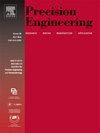Effects of pad characteristics on surface quality of soft-brittle crystals in water dissolution continuous polishing
IF 3.5
2区 工程技术
Q2 ENGINEERING, MANUFACTURING
Precision Engineering-Journal of the International Societies for Precision Engineering and Nanotechnology
Pub Date : 2025-01-25
DOI:10.1016/j.precisioneng.2025.01.015
引用次数: 0
Abstract
Water dissolution continuous polishing is essential for fabricating large-sized soft-brittle crystals to achieve global planarity and smooth surfaces. The pad, as a core component, directly affects polishing efficiency and quality. In this study, the effects of pad characteristics, including polyurethane, damping, and nonwoven materials on surface quality are extensively examined. Material properties such as surface roughness, asperity distribution, and porosity are studied to achieve high-quality surfaces. Based on the direct contact model between the pad and the workpiece, three pad surface shapes are proposed to optimize pad performance. Through a combination of trajectory uniformity simulation and experimental verification, the influence of the pad surface shape on the workpiece surface quality is systematically analyzed. The results demonstrate that the pad characteristic is a critical determinant of polishing quality. The polyurethane pads with convexity surfaces perform well in water dissolution continuous polishing due to their high hardness and low compressibility. A 200 mm × 200 mm × 10 mm KDP crystal with a surface roughness of 1.694 nm and PV of 0.153 λ is successfully obtained, significantly improving surface control efficiency and accuracy.

水溶连续抛光中衬垫特性对软脆晶体表面质量的影响
水溶连续抛光是制造大尺寸软脆晶体以获得整体平整度和光滑表面的必要条件。垫片作为核心部件,直接影响抛光效率和质量。在这项研究中,垫特性的影响,包括聚氨酯,阻尼和非织造材料对表面质量进行了广泛的研究。材料性能,如表面粗糙度,粗糙度分布和孔隙率的研究,以获得高质量的表面。基于焊盘与工件的直接接触模型,提出了三种焊盘表面形状以优化焊盘性能。通过轨迹均匀性仿真与实验验证相结合的方法,系统分析了焊盘表面形状对工件表面质量的影响。结果表明,衬垫特性是决定抛光质量的关键因素。具有凹凸表面的聚氨酯衬垫由于其高硬度和低压缩性而具有良好的水溶性连续抛光性能。成功获得了表面粗糙度为1.694 nm、PV为0.153 λ的200 mm × 200 mm × 10 mm的KDP晶体,显著提高了表面控制效率和精度。
本文章由计算机程序翻译,如有差异,请以英文原文为准。
求助全文
约1分钟内获得全文
求助全文
来源期刊
CiteScore
7.40
自引率
5.60%
发文量
177
审稿时长
46 days
期刊介绍:
Precision Engineering - Journal of the International Societies for Precision Engineering and Nanotechnology is devoted to the multidisciplinary study and practice of high accuracy engineering, metrology, and manufacturing. The journal takes an integrated approach to all subjects related to research, design, manufacture, performance validation, and application of high precision machines, instruments, and components, including fundamental and applied research and development in manufacturing processes, fabrication technology, and advanced measurement science. The scope includes precision-engineered systems and supporting metrology over the full range of length scales, from atom-based nanotechnology and advanced lithographic technology to large-scale systems, including optical and radio telescopes and macrometrology.

 求助内容:
求助内容: 应助结果提醒方式:
应助结果提醒方式:


